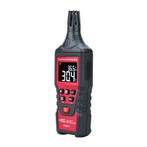The principle of laser range finder_How does laser range finder work
The principle of laser range finder
1. The principle of using infrared ranging or laser ranging
The principle of ranging can basically be attributed to measuring the time required for light to go back and forth to the target, and then calculate the distance D through the speed of light c = 299792458m/s and the atmospheric refraction coefficient n. Because it is difficult to measure time directly, it is usually to measure the phase of continuous wave, which is called phase measuring range finder. Of course, there are also pulsed rangefinders.
It should be noted that phase measurement does not measure the phase of infrared or laser, but the phase of the signal modulated on infrared or laser. The construction industry has a handheld laser distance meter for house surveying that works on the same principle.
2. The plane of the measured object must be perpendicular to the light
Usually precision distance measurement requires the cooperation of a total reflection prism, while the rangefinder used for house measurement directly measures with smooth wall reflection, mainly because the distance is relatively short and the signal strength of the light reflected back is large enough. It can be known from this that it must be vertical, otherwise the return signal is too weak and the accurate distance cannot be obtained.
3. The object plane can be measured as diffuse reflection
It is usually possible. In actual engineering, a thin plastic plate is used as a reflective surface to solve the problem of serious diffuse reflection.
4. The entertainment-grade products of the pulse method laser range finder can achieve a display accuracy of 1 meter, a measurement accuracy of ±1 meter, and a measurement-grade product with a display accuracy of 0.1 meters and a measurement accuracy of ±0.15 meters.
5. The accuracy of the phase laser rangefinder can reach 1 mm error, which is suitable for various high-precision measurement purposes.
How does the laser range finder work
Laser range finders generally use two methods to measure distance: pulse method and phase method. The process of pulse method ranging is as follows: the laser emitted by the range finder is reflected by the measured object and then received by the range finder, and the range finder records the time of the laser back and forth at the same time. Half of the product of the speed of light and the round-trip time is the distance between the rangefinder and the measured object. The accuracy of distance measurement by pulse method is generally around +/-1 meter. In addition, the measurement blind zone of this type of rangefinder is generally about 5 meters.
Laser range finders (LRFs) all use the same fundamental concept. The range finder, after pressing the button of the range finder, emits a laser beam. These beams are reflected back from distant targets, and the high-speed clock built into the rangefinder measures the total time from the time the beams are emitted to when they are reflected back. Because we know how fast the speed of the beam (ie: the speed of light) can use this time difference to measure and calculate the distance, and then display the distance from the target to the user on the screen of the rangefinder.






